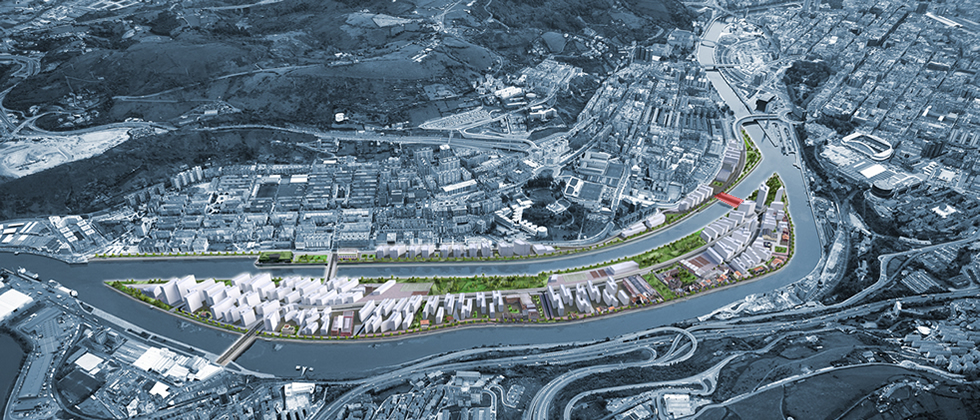OPERATIONS

Frank Gehry bridge
The bridge which will join Deusto to the future island of Zorrotzaurre has been designed by the civil engineers, Guillermo Capellán and Héctor Beade of the firm Arenas & Asociados in temporary partnership with the company CV Ingeniería.
The bridge is 75m long and is variable in width from 26.83m on the Zorrotzaurre side to 28.96m on the Deusto side. The transversal section was chosen to favour cycle and pedestrian traffic. 13m are given over to motor vehicles (two 3.25m lanes in each direction) and a minimum width of 10m for pedestrians and cyclists including a two-way cycle path 3m wide.
The estimated construction budget stands at 7.7 million Euros. Work is expected to commence towards the end of 2013, simultaneously with the Deusto Canal excavation works. The bridge is expected to come into service at the beginning of 2015.
Urban integration and transparency
The bridge is designed to integrate totally into the new road system on the island and into the existing Deusto road system and is conceived as a special street within the new urban space.
For this reason, the bridge has been designed in a straight line continuing calle Julio Urquijo on the Deusto side and connecting to the future main avenue on Zorrotzaurre for motor vehicles, cyclists and pedestrians.
The sloping road surface design guarantees that there are no blind spots for the vehicles crossing the bridge.
To achieve relative transparency, priority was given to avoiding a visual screen that would interrupt perception of the river and to avoiding the creation of a landscape element that might enter into conflict with the nearby Euskalduna bridge and the buildings that will form part of the urban development of the Island. And all this without renouncing the personality of the bridge. This has been achieved through reducing the number and size, particularly the height, of the structural elements on the bridge.
Compatibility with the system for handling river flow growth.
The bridge needs to be compatible with the system for allowing for river flow growth and so the under-part of the bridge will always be above the +4.45m level and will have an additional 1.00m clearance in the central 40m of the bridge.
Structural honesty
From a structural point of view, the canal crossing of 75m has been designed without intermediate supports to avoid making local drainage conditions worse and so that the bridge might be representative of the period in which it is being built, where there is no technical impediment for a span of that size, as can be confirmed by observing the bridges that have been built across the river in a long period prior to today.
A design has been found to marry rational and efficient levels of resistance with the self-imposed design restraints within a reasonable economic investment.
Coherence with the spatial context
The intention was to create a unique bridge through its integration into the area. A bridge that belongs to Bilbao and to Zorrotzaurre and that would lose its meaning in other locations.
To achieve this, an atypical truss solution was incorporated: an inverted variation on the classic Fink-type beam, only present in 3 pedestrian bridges (London, Stirling in Scotland and Paris).
Two inverted Fink-type beams are used as the principal structure of the bridge, with variable height masts, the heads of which are secured to the base of the neighbouring masts and with an inferior beam (also inverted) in each of them and of variable structural width and height.
These beams are situated between the road surface and the steel areas and form, as well as the main structural element of the bridge, a separating element for the different types of traffic and a place for resting (they incorporate benches). This gives a psychological sensation of protection and security to the pedestrians and cyclists and allows them to enjoy the views of the canal.
The formal language of the bridge permits a connection with other elements that characterise the river-scape of the area and continues to do so further down-river: boat masts, cranes, towers and chimneys… The design connects, in this way, with the desire to maintain the memory of the industrial and port activity already reflected in the development plan of the island through the conservation of former industrial buildings.
State-of-the-art representative of bridge technology
The design proposed is representative of the state-of-the-art of bridge technology. It is an almost unique high-tech solution without precedent in its use as a bridge for motor traffic.
Steel is the main material to be used in the construction of the bridge structure. Steel fits perfectly with the iron and steel industry tradition of the city and the river estuary. It also allows a harmonious blending-in with the other important operations carried out in recent times on the river banks which were also projected using steel or different types.


